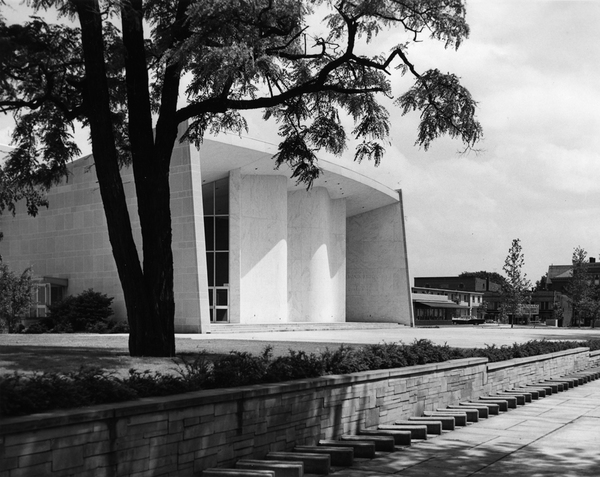Hall Auditorium
Date
1953-presentLocation
67 North Main StreetArchitects/Collaborators
Wallace Kirkman Harrison (1895-1981), New York City (architect)Albert Higley Co., Cleveland (contractor)
1960 addition: Harrison & Abramovitz (architects); Eldredge Snyder (execution architect)
2018 Kander Theater: Marous Brothers Construction (designers/builders)
Style
Neo-Expressionist
1960 addition: International
History
Sophronia Brooks Hall Auditorium was completed in 1953, even though planning for the auditorium began around the First World War, when Charles Martin Hall willed $600,000 for 'a large auditorium' in memory of his mother, to be used by both college and town to encourage 'all forms of education'. The first architect chosen to design the building was Cass Gilbert. His first design looked more like a church than an auditorium and it resembled one of his other building designs in town, Finney Chapel. However, when the college finally decided to build, the war and then postwar inflation delayed its construction. In 1929 the Great Depression and the slumping ALCOA stock, where the money to build the Auditorium was invested, no longer supported Cass Gilbert's design. Finally in 1946, the new president of the college, William Stevenson, settled on a design by architect Wallace Harrison. Harrison was the chief designer of the United Nations complex in New York City. The new building held just over 500 people when it was completed, well under the 4000-seat auditorium that was originally designed.[Geoffrey Blodgett, Oberlin Architecture: College and Town: A guide to Its Social History (Oberlin, OH: Oberlin College, 1985), 38-39.]
The dominant feature of this building is the massive, wavy wall of simulated white marble at the front facade. A flat, wide cornice stretches to the flat, stone walls at each side and extends north and south. The slab roof slants in and down towards the center and rear of the building. Entries are concealed behind the wavy wall at each side and aren’t visible from the front. In 1960 a new wing, east and north of Hall Auditorium, was completed to house the Public Speaking Department on the second floor, which moved from Sturges Hall.
It also provided facilities for a theatre in the round, the "Little Theater," on the first floor. This was replaced with a new performance space named the Kander Theater, in honor of its donor, John C. Kander (OC 1951), a composer. The Kander Theater was dedicated on March 29, 2018. The new space has a seating capacity of 75. It was designed and built by Marous Brothers Construction of Cleveland.
[Ohio Historic Inventory for Hall Auditorium by Petersen, T Reeves, M Surovy, Ohio Historic Preservation Office, August 5, 2003, accessed from the Oberlin Heritage Center website, May 26, 2015.
"Kander Theater," Oberlin College website at https://www.oberlin.edu/kander-theater, accessed 4/25/2018.
Geolocation
Image Description
Black and white, gelatin silver 8 x 10 in. vintage print by Arthur Ewing Princehorn, College photographer, June 1957
(© Oberlin College Archives, RG 32/4)

